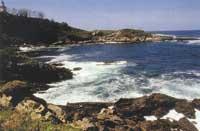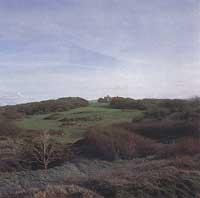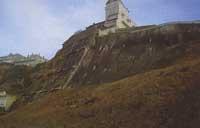Basque Coast (IX): Life on the cliffs
1995/12/01 Estonba Mintxero, Mikel Iturria: Elhuyar aldizkaria
Over millions of years, in these amazing landscapes carved by erosive agents, many living beings have acquired the appropriate biological adaptations to deal with their living conditions. All this has led to ecosystems of great diversity and originality. In it appear two main factors that directly affect living beings, one of them is coastal geomorphology and another the proximity to the sea. In short distances the influence of both factors is significantly altered, so in a few meters two distinct ecosystems appear: the intertidal and the one of the cliffs. These are what we will analyze below.
Coastal marine ecosystem
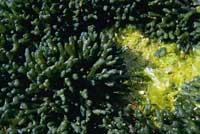
On more than one occasion it has been said that the coastline is back due to erosion. In the lowlands of the sea, we discover the flock known as a platform of abrasion of the cliff. It develops a singular ecosystem with variable conditions imposed by marine tides.
In these ecosystems, physical factors are very variable. While at high tide temperature, salinity and oxygen remain stable, in decreasing the situation is completely different. The lack of water in the lowering ecosystem imposes harsh conditions on living beings, but it is not the only obstacle. And when the weather is sunny, the temperature and salinity of the wells rise a lot, while the rainy weather can cause the opposite effect.
All these factors, as well as luminosity, wind, wave strength, etc., impose extreme living conditions on living beings. To combat them, throughout evolution, they have developed specific adaptations that make the ecological value of these ecosystems very important.
However, not all of the above factors affect the entire platform in the same way. The area closest to the level of the pleamar only gives flooded for a few hours, but the closest to the level of the bajamar passes almost all day under water. This phenomenon produces biological gradients and, depending on them, the living beings of the ecosystems are structured. Thus, the most sustainable to be able to live without water live on the top of the platform and the least sustainable on the bottom.
Vegetation vegetation vegetation vegetation vegetation vegetation vegetation
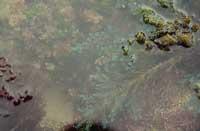
Due to the living conditions we have mentioned, in this ecosystem algae are the representatives of the vegetable kingdom and we can affirm that they are clear exponents of the gradients we have defined previously.
At the top of the platform, that is, in which water covers for a short time, green algae predominate. Among them, the most abundant are the eel grass (Enteromorpha minima) and the marine urrace (Ulva lactuca), well known for their slip. Despite their predominance, they are not unique and, although in less quantity, there are other species of green algae: Codium tomentosum, etc.
Below, in areas where water makes the filtration of the sun's rays more visible, in addition to chlorophyll in the tissues, are brown and red algae containing numerous pigments called carotenes and xanthophylls.
Although the influence of the gradients is more difficult to detect, the distribution of these two groups of algae is different: if we look at them, we will see that the males live higher than the reds. As for brown algae, the following species are remarkable in the Basque Country: Cystoseira tamaristifolia, of iridescent colour under the water, Bifurcaria rotunda, of tubular aspect and dichotomous ramification, and Fucus espiralis, of ribbons aspect and dichotomous ramification, that in its ends houses bodies full of coarse and similar Fuatus.

Undoubtedly, the group of algae that presents a greater degree of diversity is the most reddish algae. This group of algae appears at the bottom and in the wells abandoned by the tides, collecting on the coast of the Basque Country numerous species of different form and structure. Among them, it is worth mentioning the inlaid algae that have a stony appearance due to the presence of calcium carbonate in the tissues, which often cover a large substrate width. Among the inlaid algae, the best known on our coast are those of the genus Lythophyllum, Lithothamium and Corallina.
Do not forget the Gelidium sesquipedale or Ceramium rubrum that is lately being exploited on our coasts.
Animals animals animals animals animals animals
Animals are scarce than algae in these ecosystems, which makes it difficult to recognize gradients. In any case, a concrete observation could easily solve this problem.
As soon as we approach the top of the platform, we will discover that the rocks are filled with small animals of light color and with a hard shell. They are sea acorns (Chtamalus sp. and Balanus sp. ), crustaceans able to live long outside the water.
Next to them, flaps of the filum of molluscs (Patella sp.) They appear frequently, thanks to their strong muscle feet stick strongly to the rocks to prevent the waves from carrying them.
At the top it is also very common to see the green crab (Carcinus maenas) and the black crab (Pachygrapsus marmoratus) that move very quickly through the rocks. They feed on algae and, like sea acorns, they are able to live outside the water.

Below, having to stay less time without water in bajamar, the presence of animals is greater and the greatest animal diversity occurs in the pools abandoned by the tides. They are natural aquarium and host representatives of numerous filums.
Among the animals of the marine ecosystem, we must also mention the birds that use native resources in times of migration. Among those who have presence throughout the year, stand out the Gaviota Patiamarilla (Larus cachinnans), the Gaviota Reidora (L. ridibundus) and the Gaviota Sombre (L. fuscus), who capture crabs to complete their diet. Among the migrants, the stone preserver (Arenaria interpreter) who mainly feeds on small crustaceans and molluscs, the dark reel (Calidris marina), the eyebrow zarapito (Numenius phaeopus), the sting (Tringa hypoleucos) or the cormorants (Phalacorax sp.) It should be highlighted.
Ecosystem cliff side
On the platform of abrasion, above the level of the pleamar, are the cliffs that have not yet fallen by effect of the drawer. In it, like the intertidal ecosystem, we find an ecosystem of cliffs that establishes demanding living conditions.
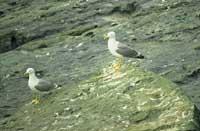
As discussed above, the factor that most directly affects living beings in the intertidal ecosystem is the tide, but in the cliffs there are other factors to take into account. Among them, it is worth highlighting:
- Due to the action of the drawer, the erosion is very high and the formation of the soil is null.
- The splash of water with high salinity generates problems of osmosis for living beings and especially for plants. In addition, it contributes to a greater reduction of low soil.
- Due to the strong wind, the plants of great height cannot grow and the dryness is high, since the wind and the sun increase the perspiration of the plants.
All these factors make life in these ecosystems scarce. At the same time, some animals and plants have achieved adaptations that are useful for staying in the ecosystem, which provides a great originality.
However, the influence of these factors is not the same throughout the cliff. In the area closest to the sea, the strong slopes and the influence of the sea are the conditions of life and as it moves away from the sea, the influence of these factors decreases and the wind acquires greater prominence.
According to this, three great differences can be distinguished in the cliffs:
- The rocky cliff closest to the sea,
- low-slope cliff with numerous slopes and cornices and
- Top of the cliffs.
Vegetation of cliffs
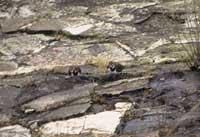
Due to the aforementioned factors, the scarce vegetation of rocky cliffs is of great ecological value due to the harsh living conditions and the original adaptations that have been given throughout the evolution.
In the first zone, that is, in the grooves and cracks that splash the waves during the pleamares and strongly agitate the drawers in the days of storm, there are species adapted to the action of the salinity and the lack of soil, among which are the marine fennel (Crithmum maritimum) and the marine plant (Planttimago maritima), the repopulation of Asmarium mariettum.
As it ascends, the slope and influence of the sea soften. The presence of plants increases, since the increase of the soil facilitates its presence. In these areas the pruinous herb Festuca rubra predominates and, among others, in slopes and cornices, we find other species such as San Juan Lorea (Leucanthemum crassifolium), marine carrot (Daucus gummifer), yellow betibicón (Helichrysum stollodades), Basque herbaceous species (Labelímara). In this area, the French Taray (Tamarix gallica) also appears shrub and is the only large plant that lives in these harsh conditions. All of them constitute the association Leucanthemo crassifoli-Festucetum pruinosae.
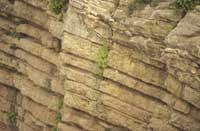
When the slope disappears in the upper part, the cresal effect is much smaller, but it must be taken into account. However, the wind is the one that establishes the living conditions, so the vegetation that appears in this area is known as “aerohalino” (aero=wind and halino = salinity). All these plants are characterized by the formation of shrubby communities of substitution adapted to the conditions of life imposed by the wind and the salinity of the environment.
Among the adaptations stand out the piled aspect of the plants to resist the strength of the wind and to be able to stand, as well as the network of leaves and branches. Among the plants that make up these communities stand out the otea (Ulex europaeus and U. cantabricus), the common basket (Genista hispanica) and the Burusoila eel (Erica vagans). Often, between them and on them appear the endalaharra (Smilax aspera), the otxar silvestre (Blonde pilgrim), the ivy common (Hedera helix) and the lamb (Rosa sempervirens). All of them make up the association Daboecio-Ulicetum galii genistetosum.
Among the largest plants stand out the corks (Rhamnus aalternus) and the madroño (Arbutus unedo) that can be seen on the top of our cliffs. Among the herbs, the grass of broom (Brachipodium pinnatum) is the most widespread.
Animals of cliffs
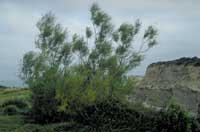
As has been said more than once, this ecosystem imposes very harsh living conditions on plants, but even more on animals. For this reason, there are few animals that inhabit the cliffs and most live in the upper part of the cliff.
However, the difficulty of access to these ecosystems makes it an ideal place for the nidification of some species of birds, since in some cases this ecosystem is appropriate to protect the breeding of predators.
Among the species of birds that nest on the cliffs of the Basque Country stand out the rodete (Corvus corax), the red falcon (Falco tinnunculus), the pilgrim falcon (Falco peregrinus), the dark arcillón (Phoenicurus ochruros), the petirón (Troglodytes troglodayo halicesso), the haliche
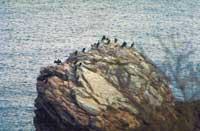
Special mention deserves the small Country (Hydrobates pelagicus). This pelagic bird is fed by day plactonas at sea and returns to the night coast. He usually builds his nest on islands and rocks. A few years ago we had no reliable data on the presence of this bird on the Basque coast. However, thanks to the work done by biologist Eduardo Minguez, we can affirm that in most of the islands and rocks of our coast nidifies the country of the country.
In addition to the species that nest on the cliffs, the vikust species (which do not live on the cliffs but exploit the resources offered by these areas) appear. These are located on the top of the cliffs. Among them are the rocky bird (Tichodroma muraria), the petirrojo (Erithacus rubecula), the mirlo (Turdus merula), the common charcoal (Parus major), the grey fly bird (Musciivalcapa striata), the black vase (Saxicola), the chatesa,

Gai honi buruzko eduki gehiago
Elhuyarrek garatutako teknologia




